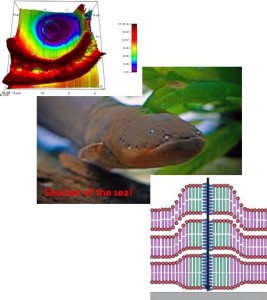Multilamellar lyotropic phases of stacked lipid bilayers exhibiting smectic liquid-crystalline order (or membrane multilamellae) are spontaneously produced primarily through hydrophobic forces resulting from lipid water interactions. Continued interest in these membrane multilamellae can be attributed to their relevance in many areas of fundamental research and practical applications. In living systems, such multilamellar membranous structures are present as lamellar bodies. They also occur in many active biological assemblies that control energy transduction. For instance, thylakoid membranes of photosynthetic cyanobacteria or plant chloroplasts, and electrocyte cells in electric eels are highly folded membranous structures that combine single membrane functions in series, which because of their energy harvesting capabilities hold considerable technological potential for biomimicry. Moreover, potential for applications in photonics, sensing and DNA delivery (for example, gene therapy and synthetic biology), further fuels interest in these liquid-crystalline multilamellar membranes.
In the past, studies of multilamellar membranes have focused dominantly on uniform systems consisting of single lipids. Biological membrane mesophases and those relevant to practical biomimetic applications, however, are seldom uniform. Multicomponent mixtures of lipids and proteins, which readily phase-separate into coexisting phases, characterize these functional membrane multilamellae. This raises the possibility that two dimensional intralayer phase separation of lipids and proteins in individual membrane lamellae couples with the interlayer smectic ordering to align functional components across membrane lamellae in a self-organized manner. However, such higher-order organization in multilayered membranes has not yet been demonstrated.
Achievments

Figure 1: The stacked series of ion channels in electric eels can generate 600V, 1A pulsed electric power. A phase separated stacked lipid domain is shown on top left and the schematic of the series ion channels (blue) in this stack is shown in the bottom right picture.
We recently discovered a long-range inter-layer alignment of intra-layer domains in stacked lipid bilayers (Nature Materials, DOI: 10.1038/N MAT3451 2012). This work was a multi-university research involving OSU, UC Davis, and UCSD. Our work was highlighted on the front cover page of the journal and in ‘the article in the news’ of the Nature website.
In this work we showed that multicomponent lipid multilayers can self-organize themselves in a columnar order across hundreds of membrane lamellae. Such a long range alignment of phase-separated domains is fascinating as it happens autonomously. We showed that this liquid crystalline structure forms due the strong coupling of two-dimensional intralayer phase separation and interlayer smectic ordering.
Inspired from this discovery, we are investigating power generation using stable multilayer lipids with embedded ion channels very much like in an electric eel. An electric eel is able to generate about 600 volts of 1 ampere current by converting the ion concentration gradient into the action potential strong enough for useful power generation.